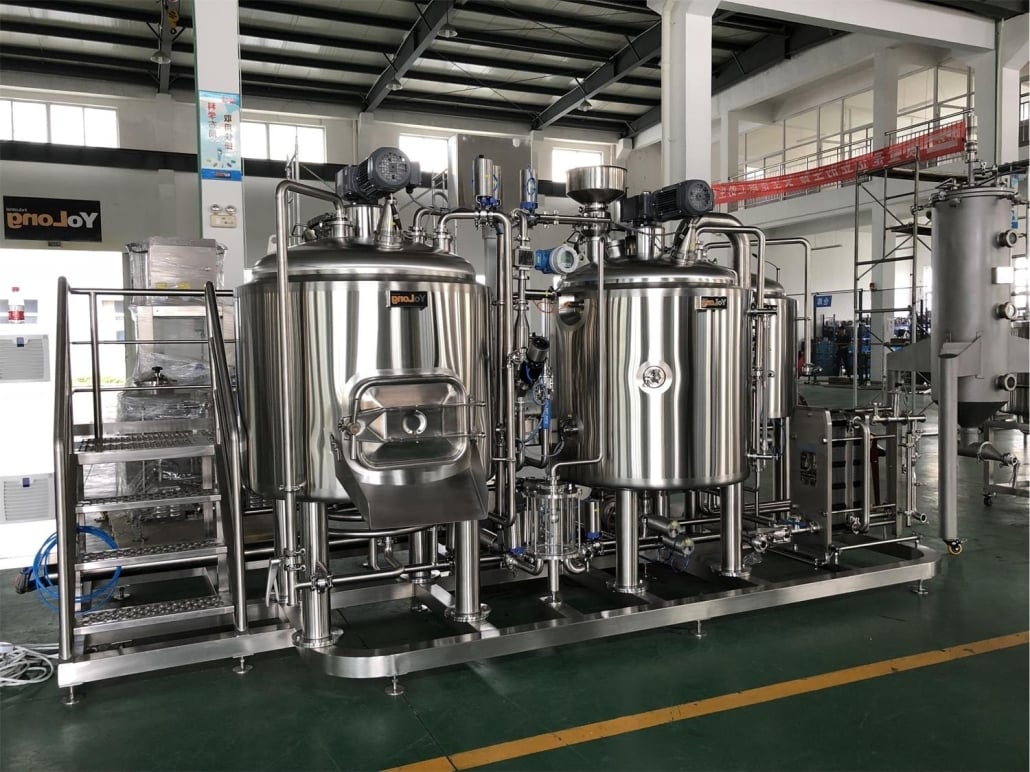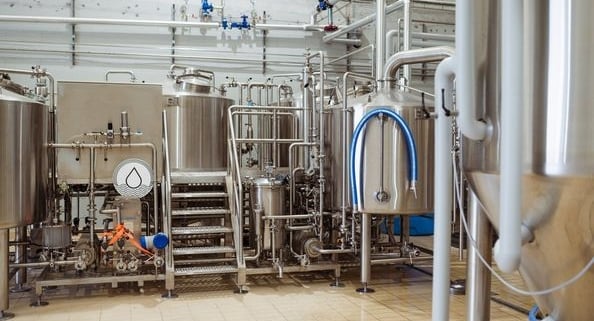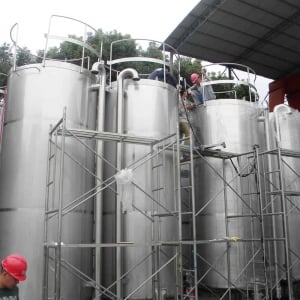Fermenter Tanks
Fermenter tanks are the unsung heroes of the brewing world. These seemingly simple vessels are the workhorses behind every delicious sip of beer, wine, cider, or kombucha you enjoy. But what exactly are fermenter tanks, and how do they play such a crucial role in the fermentation process?
In this comprehensive guide, we’ll delve into the fascinating world of fermenter tanks. We’ll explore the different types available, their features, how they contribute to the brewing process, and the factors to consider when choosing the perfect tank for your needs.
An Overview of Fermenter Tanks
Fermentation is a biological process where yeast or bacteria convert sugars into alcohol, carbon dioxide, and other byproducts. In brewing, this process transforms wort (unfermented beer) into beer. Fermenter tanks provide a controlled environment for this transformation to occur. They are typically sealed vessels equipped with temperature control mechanisms and pressure relief valves to ensure optimal conditions for the yeast or bacteria to thrive.
The size and design of fermenter tanks can vary greatly depending on the type of beverage being produced and the scale of the brewing operation. Homebrewers might use small, portable tanks, while commercial breweries utilize massive, industrial-grade fermenters.

Types of Fermenter Tanks
The world of fermenter tanks offers a variety of options to suit different brewing needs. Here’s a breakdown of the most common types:
| Type of Fermenter Tank | Description | Advantages | Disadvantages |
|---|---|---|---|
| Cylindrical Fermenters (CFs) | The most widely used type, featuring a cylindrical body with a dished bottom. | – Simple design – Versatile for various beverages – Easy to clean | – Less space-efficient compared to conical fermenters |
| Conical Fermenters (CTs) | Characterized by a cone-shaped bottom that facilitates yeast collection and easier removal of sediment. | – Improved yeast management – Reduced risk of off-flavors – Potential space savings | – Slightly more complex design |
| Unitanks | Multi-functional tanks that combine fermentation, conditioning, and serving functions into a single vessel. | – Space-saving – Efficient for small breweries | – Less flexibility compared to dedicated fermenters – Potential challenges with cleaning and monitoring |
| Pressure Tanks | Designed to withstand higher pressure levels, allowing for fermentation with certain yeast strains or production of carbonated beverages. | – Suitable for specific brewing styles – Greater control over carbonation | – Requires additional safety considerations – May not be necessary for all brewers |
| Plastic Fermenters | Affordable and lightweight option, ideal for homebrewers. | – Cost-effective – Easy to handle | – Can be susceptible to scratches and staining – May not be suitable for high temperatures |
Features of Fermenter Tanks
Beyond the basic types, fermenter tanks come equipped with various features to enhance the brewing process. Here are some key elements to consider:
- Material: Stainless steel is the most common material due to its durability, ease of cleaning, and resistance to corrosion. However, plastic fermenters offer a more budget-friendly option for homebrewers.
- Capacity: The size of the tank will depend on the volume of beverage you plan to produce. Homebrew tanks typically range from 1 gallon to 5 gallons, while commercial tanks can hold thousands of gallons.
- Jackets: Jacketed fermenters feature a double wall that allows for the circulation of coolant or heating fluid to maintain consistent fermentation temperatures. This is crucial for temperature-sensitive brews.
- Pressure Relief Valves: These valves prevent excessive pressure buildup within the tank, ensuring safety during fermentation.
- Sampling Ports: Allow brewers to extract small amounts of liquid to monitor the progress of fermentation.
- Carbonation Stones: Used to carbonate beverages within the tank by injecting CO2.
The Brewing Process and the Role of Fermenter Tanks
Fermentation is a delicate dance between yeast, temperature, and time. Fermenter tanks provide the controlled environment needed for this dance to produce a successful brew. Here’s a simplified breakdown of the brewing process and how fermenter tanks contribute:
- Wort Production: The brewing process begins with the creation of wort, a sugary liquid extracted from malted grains.
- Transfer to Fermenter: The wort is transferred to the sterilized fermenter tank after it has been cooled and aerated.
- Yeast Pitching: Yeast is introduced into the wort, initiating the fermentation process.
- Temperature Control: The fermenter tank’s temperature control system maintains the optimal temperature range for the chosen yeast strain.
- CO2 Production: During fermentation, yeast consumes sugars in the wort and produces alcohol and CO2. The pressure relief valve vents excess CO2.
- Maturation: After active fermentation subsides, the beer enters a maturation stage where it rests and flavors develop. Some tanks are designed for both fermentation and conditioning, while others necessitate transferring the beer to a separate conditioning tank.
- Packaging: Once the beer has reached its peak maturity, it is filtered, carbonated (if desired), and packaged into kegs, bottles, or cans.
Fermenter tanks play a critical role in each of these stages. They provide a sterile environment to prevent contamination, ensure consistent temperatures for optimal yeast activity, and facilitate pressure control to avoid tank ruptures. Additionally, features like sampling ports allow brewers to monitor the progress of fermentation and adjust parameters if needed.
Choosing the Right Fermenter Tank
With the vast array of fermenter tanks available, selecting the perfect one for your brewing needs can feel overwhelming. Here are some key factors to consider:
- Scale of Brewing: Homebrewers will have different requirements compared to commercial breweries. Consider the volume of beer you typically produce and choose a tank size that comfortably accommodates your batch sizes.
- Budget: Fermenter tanks can range in price from affordable options for homebrewers to significant investments for commercial breweries. Determine your budget and prioritize features that align with your needs.
- Material: Stainless steel offers superior durability and sanitation, making it ideal for most brewers. Plastic tanks are a budget-friendly option for homebrewers, but they may not be suitable for high temperatures or repeated use.
- Features: Consider the features that will enhance your brewing process. Jacketed tanks are essential for temperature-sensitive brews, while pressure tanks are necessary for specific styles or carbonation.
- Ease of Use: If you’re a homebrewer, prioritize tanks that are easy to clean, fill, and operate. Consider factors like portability and the availability of cleaning accessories.
- Expandability: If you envision scaling up your brewing operation in the future, choose a tank system that can accommodate growth. Some modular systems allow you to add additional tanks as needed.
Here’s a table summarizing some key considerations for choosing a fermenter tank:
| Factor | Description |
|---|---|
| Scale of Brewing | Homebrew vs. Commercial |
| Budget | Cost of the tank and desired features |
| Material | Stainless steel vs. Plastic |
| Features | Jacketed tanks, pressure valves, sampling ports, etc. |
| Ease of Use | Cleaning, filling, operation |
| Expandability | Potential for adding more tanks in the future |
By carefully evaluating these factors, you can make an informed decision that ensures your fermenter tank becomes a reliable partner in your brewing journey.
Fermenter Tanks: Price Range
The price of fermenter tanks varies significantly depending on size, material, features, and brand. Here’s a general breakdown to provide a starting point for your research:
| Tank Capacity | Material | Typical Price Range |
|---|---|---|
| Homebrew (1-5 gallons) | Plastic | $50 – $200 |
| Homebrew (5-15 gallons) | Stainless Steel | $200 – $500 |
| Commercial (50-500 gallons) | Stainless Steel | $1,000 – $10,000+ |
| Commercial (1,000+ gallons) | Stainless Steel | $10,000+ |
It’s important to note that these are just ballpark figures. Prices can fluctuate depending on specific features, brands, and current market conditions.
Installation, Operation, and Maintenance of Fermenter Tanks
Proper installation, operation, and maintenance of your fermenter tank are crucial for ensuring its longevity and optimal performance. Here’s a basic outline of these processes:
Installation:
- Follow the manufacturer’s instructions carefully for proper tank setup.
- Ensure the tank is placed on a level, stable surface that can support its weight when filled.
- Connect any necessary hoses, valves, and fittings according to the instructions.
Operation:
- Prior to each use, thoroughly clean and sanitize the fermenter tank and all associated equipment.
- Carefully transfer the wort to the sterilized tank and pitch the yeast according to your recipe.
- Monitor the fermentation process using the tank’s temperature control system and sampling ports (if available).
- Maintain proper pressure levels by ensuring the pressure relief valve is functioning correctly.
Maintenance:
- After each use, disassemble the tank as much as possible and clean all components thoroughly using a no-rinse sanitizer or other approved cleaning solutions.
- Regularly inspect the tank for signs of wear and tear, leaks, or damage.
- Perform preventative maintenance as recommended by the manufacturer, which may include lubricating specific parts or replacing gaskets.
Choosing a Fermenter Tank Supplier
Selecting the right supplier for your fermenter tank is just as important as choosing the tank itself. Here are some key factors to consider when evaluating potential suppliers:
- Reputation and Experience: Look for a supplier with a proven track record in the brewing industry. Read online reviews and testimonials from other brewers to gauge their experience and customer satisfaction.
- Product Selection: Ensure the supplier offers a variety of fermenter tanks to suit your specific needs and budget. Consider the types, sizes, materials, and features available.
- Quality and Standards: Choose a supplier that prioritizes quality and adheres to industry standards for food-grade equipment. inquire about the materials used and any certifications the tanks possess.
- Customer Service: Responsive and knowledgeable customer service is crucial for troubleshooting any issues or seeking advice. Look for a supplier that offers ongoing support and readily answers your questions.
- Warranty and Guarantees: A solid warranty on the tank protects you in case of manufacturing defects or malfunctions. Understand the terms and conditions of the warranty offered by each supplier.
- Price and Value: While cost is a factor, prioritize value over the cheapest option. Consider the overall quality, features, warranty, and customer service when evaluating the price.
Here’s a table summarizing the key considerations for choosing a fermenter tank supplier:
| Factor | Description |
|---|---|
| Reputation & Experience | Track record in the brewing industry |
| Product Selection | Variety of tanks to suit your needs |
| Quality & Standards | Food-grade materials and industry adherence |
| Customer Service | Responsiveness and knowledgeable support |
| Warranty & Guarantees | Protection against defects or malfunctions |
| Price & Value | Balance cost with overall quality and features |
By thoroughly evaluating potential suppliers based on these criteria, you can ensure you partner with a reputable company that provides the right fermenter tank and the support you need for successful brewing.
Pros and Cons of Fermenter Tanks
Fermenter tanks offer numerous advantages for brewers, but it’s also important to acknowledge some limitations. Here’s a balanced perspective:
Pros:
- Controlled Environment: Fermenters provide a sterile and controlled environment that optimizes fermentation conditions for consistent, high-quality brews.
- Temperature Control: The ability to precisely control fermentation temperature is essential for many beer styles and ensures optimal yeast activity.
- Pressure Management: Fermenters allow for pressure control, preventing tank ruptures and enabling the production of carbonated beverages.
- Monitoring and Sampling: Sampling ports within the tank facilitate monitoring fermentation progress and making adjustments if needed.
- Scalability: Modular fermenter systems allow brewers to expand their operations by adding additional tanks as their production volume grows.
- Cleaning and Sanitization: Many fermenter tanks are designed for easy disassembly and cleaning, promoting sanitation and reducing the risk of contamination.
Cons:
- Cost: High-quality fermenter tanks, particularly for commercial breweries, can be a significant investment.
- Space Requirements: Larger fermenter tanks require dedicated space, which may be a limitation for homebrewers or breweries with limited space.
- Complexity: While many fermenter tanks are user-friendly, some features like jacketing systems may require additional technical knowledge to operate effectively.
- Maintenance: Proper cleaning and maintenance are essential for maintaining the integrity of the tank and ensuring optimal performance. This requires time and commitment.
Ultimately, the pros of fermenter tanks far outweigh the cons for most brewers. The ability to control fermentation conditions significantly enhances the quality and consistency of your brews, justifying the investment for both homebrew enthusiasts and commercial operations.

FAQ
Q: What size fermenter tank do I need?
A: The ideal fermenter tank size depends on the volume of beer you typically brew. Homebrewers typically use tanks between 1 and 15 gallons, while commercial breweries require much larger tanks ranging from 50 gallons to thousands of gallons or more. Consider your batch sizes and potential future growth when choosing a tank size.
Q: What is the difference between a cylindrical fermenter (CF) and a conical fermenter (CT)?
A: CFs are the most common type, featuring a cylindrical body with a dished bottom. They’re versatile for various beverages but may be less space-efficient. CTs have a cone-shaped bottom that facilitates easier yeast collection and sediment removal. They may be slightly more complex in design but offer advantages for yeast management.
Q: Do I need a jacketed fermenter tank?
A: Jacketed tanks allow for precise temperature control through a circulating coolant or heating fluid. This is crucial for some temperature-sensitive beer styles but may not be necessary for all brewers. If you plan to brew styles with specific temperature requirements.













